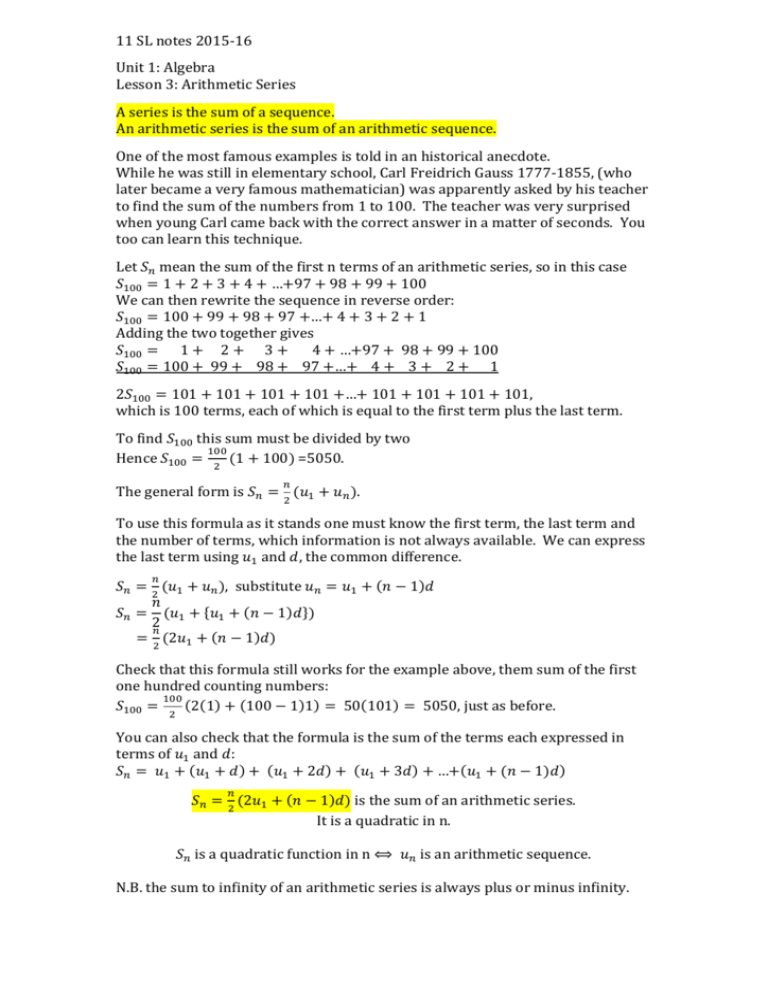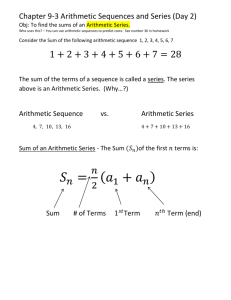Notes 11SL Unit 1 Algebra Lesson 3
advertisement

11 SL notes 2015-16
Unit 1: Algebra
Lesson 3: Arithmetic Series
A series is the sum of a sequence.
An arithmetic series is the sum of an arithmetic sequence.
One of the most famous examples is told in an historical anecdote.
While he was still in elementary school, Carl Freidrich Gauss 1777-1855, (who
later became a very famous mathematician) was apparently asked by his teacher
to find the sum of the numbers from 1 to 100. The teacher was very surprised
when young Carl came back with the correct answer in a matter of seconds. You
too can learn this technique.
Let 𝑆𝑛 mean the sum of the first n terms of an arithmetic series, so in this case
𝑆100 = 1 + 2 + 3 + 4 + …+97 + 98 + 99 + 100
We can then rewrite the sequence in reverse order:
𝑆100 = 100 + 99 + 98 + 97 +…+ 4 + 3 + 2 + 1
Adding the two together gives
𝑆100 = 1 + 2 + 3 +
4 + …+97 + 98 + 99 + 100
𝑆100 = 100 + 99 + 98 + 97 +…+ 4 + 3 + 2 + 1
2𝑆100 = 101 + 101 + 101 + 101 +…+ 101 + 101 + 101 + 101,
which is 100 terms, each of which is equal to the first term plus the last term.
To find 𝑆100 this sum must be divided by two
100
Hence 𝑆100 = 2 (1 + 100) =5050.
𝑛
The general form is 𝑆𝑛 = 2 (𝑢1 + 𝑢𝑛 ).
To use this formula as it stands one must know the first term, the last term and
the number of terms, which information is not always available. We can express
the last term using 𝑢1 and 𝑑, the common difference.
𝑛
𝑆𝑛 = 2 (𝑢1 + 𝑢𝑛 ), substitute 𝑢𝑛 = 𝑢1 + (𝑛 − 1)𝑑
𝑛
𝑆𝑛 = (𝑢1 + {𝑢1 + (𝑛 − 1)𝑑})
2
𝑛
= 2 (2𝑢1 + (𝑛 − 1)𝑑)
Check that this formula still works for the example above, them sum of the first
one hundred counting numbers:
100
𝑆100 = 2 (2(1) + (100 − 1)1) = 50(101) = 5050, just as before.
You can also check that the formula is the sum of the terms each expressed in
terms of 𝑢1 and 𝑑:
𝑆𝑛 = 𝑢1 + (𝑢1 + 𝑑) + (𝑢1 + 2𝑑) + (𝑢1 + 3𝑑) + …+(𝑢1 + (𝑛 − 1)𝑑)
𝑛
𝑆𝑛 = 2 (2𝑢1 + (𝑛 − 1)𝑑) is the sum of an arithmetic series.
It is a quadratic in n.
𝑆𝑛 is a quadratic function in n ⟺ 𝑢𝑛 is an arithmetic sequence.
N.B. the sum to infinity of an arithmetic series is always plus or minus infinity.
11 SL notes 2015-16
e.g. For the arithmetic sequence 1, 5, 9, 13, … find 𝑆20
𝑢1 = 1, 𝑑 = 4
𝑛
𝑆𝑛 = {2𝑢1 + (𝑛 − 1)𝑑}
2
20
𝑆20 =
{2(1) + (20 − 1)4}
2
=780
e.g. Find 𝑆20 for the sequence which has 𝑢5 = 19 and 𝑢7 = 27.
𝑢7 − 𝑢5 = 2𝑑 = 8, so d=4.
Using 𝑢5 = 19, 19 = 𝑢1 + (5 − 1)4
Hence 𝑢1 = 3
𝑛
𝑆𝑛 = {2𝑢1 + (𝑛 − 1)𝑑}
2
20
𝑆20 =
{2(3) + (20 − 1)4}
2
=820
e.g. In an arithmetic series, 𝑆20 = 710 and 𝑑 = 3. Find 𝑢1 , and hence find 𝑢25
and 𝑆25 .
𝑛
𝑆𝑛 = {2𝑢1 + (𝑛 − 1)𝑑}
2
20
𝑆20 =
{2(𝑢1 ) + (20 − 1)3}
2
710=10{2(𝑢1 )+57}
𝑢1 =
710
−57
10
2
=7
𝑢25 = 7 + (25 − 1)3 = 79
𝑆25 =
25
{7 + 79} = 1075
2
e.g. Prove that the series whose sum for the first n terms is 𝑛2 must be an
arithmetic series.
𝑛
𝑆𝑛 = {2𝑢1 + (𝑛 − 1)𝑑}
2
𝑛
2
𝑛 = {2𝑢1 + (𝑛 − 1)𝑑}
2
𝑑
𝑛 = 𝑢1 + (𝑛 − 1)( 2) which is a term in an arithmetic sequence.
11 SL notes 2015-16
e.g. In an arithmetic progression 𝑢1 = 5, 𝑑 = 3, and 𝑆𝑛 = 55.
Find n, and hence write down all the terms that add to 55.
N.B. Sigma notation. Σ is the capital Greek letter sigma, and it is also used to
indicate a sum.
e.g.
𝑛
∑(𝑘 + 1)
𝑘=1
means the sum of the first n terms of the series 2+3+4+5+6…
e.g. Evaluate
10
∑(𝑘 − 3)
𝑘=1
Now try Ex 6F, page 169, focus on questions 4 to 12. You may come to M106 for
study hall on Thursday P1&2, but you need to have tried the questions before
you come.




![Information Retrieval June 2014 Ex 1 [ranks 3+5]](http://s3.studylib.net/store/data/006792663_1-3716dcf2d1ddad012f3060ad3ae8022c-300x300.png)



